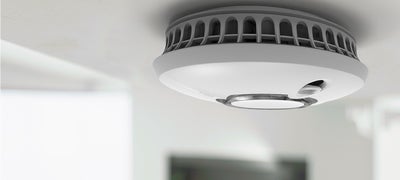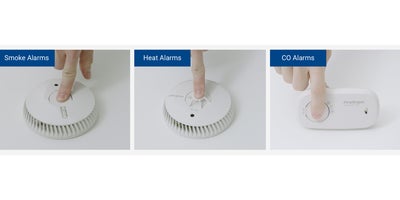Protecting your home with smoke, heat and carbon monoxide alarms

This guide will help you choose the right alarms to alert you to fire and carbon monoxide risks in your home. There are specific regulations applicable to the type of home and its location across the country. Please use this guidance alongside localised information.
What alarms should I fit in my home?
There are different types of alarms to suit different needs or rooms. The below gives an overview, but don’t forget to check the legislation and regulations for your location and property type to ensure you fit the right devices.
Smoke alarms
Heat alarms
Carbon monoxide alarms
What's the difference between battery powered and mains powered alarms?
Battery-powered alarms
Mains-powered alarms
What alarms do I legally need to install in my home?
Legislation and regulations depend on the area you live in (e.g. England, Wales, NI or Scotland), the type of property you live in or own (e.g. owner-occupied, rented), and the material state of the property (e.g. existing, or being extended/rewired). Please use the below as guidance only, using local resources to confirm.
Alarms for homes in England
Alarms for homes in Wales
Alarms for homes in Northern Ireland
Alarms for home in Scotland
How do you install a smoke alarm?
Battery-powered alarms have been designed to be installed quickly and simply, without the services of an electrician.
The below provides an overview of installing your smoke alarm, but please refer to each alarm’s installation manual for tailored guidance.
Where should I position the smoke alarm?
Installing your smoke alarm
How do you install a heat alarm?
Battery-powered alarms have been designed to be installed quickly and simply, without the services of an electrician.
The below provides an overview of installing your alarm, but please refer to each alarm’s installation manual for tailored guidance.
Where should I position the heat alarm?
Installing your heat alarm
How do you install a carbon monoxide alarm?
The below provides an overview of installing your carbon monoxide detector, but please refer to each alarm’s manual for tailored guidance.
Where should I position the CO alarm?
How often should you replace or test your alarms?

Your smoke and carbon monoxide (CO) alarms are your first line of defence in an emergency — but only if they’re working properly. Regular testing and timely replacement are essential.
The simple rule: test your alarms once a month.
Press the test button and listen for the beep. If nothing happens, replace the batteries or the unit, depending on the type. Make this part of your monthly routine — maybe on the first of every month.
How often should I replace my alarms?
How do I know when it’s time to replace the alarm?
How do you maintain smoke, heat and carbon monoxide alarms?
With regular maintenance, you can improve your alarm's longevity and accuracy.
When?
How?
What does interlinked or interconnected mean?
Interlinked refers to alarms which are connected into a network across the home, allowing them to alert as one. This gives a loud, clear alert across the home instantly, allowing additional time to react to the
danger.
This can be completed using a hardwired interlink, where a physical cable connects the alarms, or via a wireless module which is installed in some alarms. Some alarms can be added to a ‘hybrid’ network where both hardwired and wireless interlink is used, removing the need for additional wiring.
Are there smart smoke alarms?
Yes, smart alarms are available from Wickes. FireAngel’s Pro Connected alarms can be connected to a gateway and an app which allows remote control and testing of the alarms. It will provide alerts to risk on the go, and can be paired with multiple networks, enabling the user to receive notifications for their elderly relative or rented properties too.












